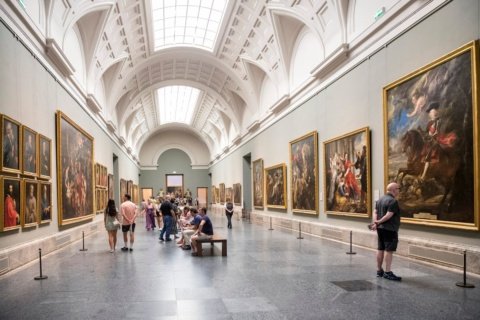For Édouard Glissant, the Martinican philosopher and poet, the archipelago wasn’t merely a unique geographical formation but a metaphor for understanding identity, culture and human relationships. This perspective comes alive in the works of New York-based Jamaican artist Arthur Simms, whose creations are currently on view at Kunstmuseum St. Gallen in Switzerland. The exhibition, titled ‘Chair with my Hair’, echoes Glissant’s vision of the Caribbean archipelago, highlighting the intricate dance between roots – our connection to cultural heritage and history – and routes: the paths of movement, exploration and cultural exchange.

A signature element in Simms’s oeuvre since the 1980s is his own hair. Laden with symbolism, it represents roots in both a literal and figurative sense. The hair in his works, such as the titular Chair with my Hair (2024) – a small square of black hair on a modest school chair, mounted on a child’s sledge and set on a pair of wooden beams between two large blocks of crushed aluminium cans – acts as a genetic signature, directly linking his practice to his African heritage. This symbol of pride and identity is problematized in works like A Day, One Halo (2020), where Simms intertwines his hair with the auburn locks of his wife, the US painter Lucy Fradkin, creating a visual metaphor for the blending of cultures and identities.

Glissant’s concept of ‘relational identity’, as developed in Poetics of Relation (1990), is palpable in Simms’s work, emphasizing selfhood as fluid and ever-evolving, shaped by interactions and exchanges. This notion is beautifully illustrated in pieces that draw from a plethora of cultural references beyond Simms’s Afro-Caribbean roots. For instance, Crown (2023) and Dreamcatcher VII (2004) nod explicitly to Native American cultural motifs, while his drawings, such as those in Forty-eight Inch (2022), fuse Arabic-type script with the gestural mark-making of American abstract expressionist painters like Willem de Kooning, Jackson Pollock and Cy Twombly.

Art history plays a pivotal role in Simms’s work, as evidenced by his ‘Black Caravaggio’ series (1990–2009). Juxtaposing postcard images of Caravaggio’s paintings with images of folk or non-western art, framed by vibrant colours, silvery charcoal borders and tufts of hair, this series echoes Aby Warburg’s Mnemosyne Atlas (1924–29). Just as the German art historian attempted to trace the influence of antiquity’s symbolic power through time, Simms’s series charts his own artistic journey, from his fellowships in Rome to his perusal of art collections in Prague and Dublin. In works like Light, Black Albrecht (2005), Simms unites fragments of Caravaggio’s and Albrecht Dürer’s works with his own hair, asserting a personal and creative dialogue across cultures and epochs with these art-historical giants.

Simms also engages with lesser-known interlocutors in pieces like Francesca’s Horse (2023) and Shark (2023), which incorporate objects given to the artist by a worker from the Church of San Carlo in Cremona, where Simms exhibited last year. The integration of such items testifies to the artist’s desire to make art out of social interactions. This is relational art of a distinctively Glissantian type, characterized by tightly wound and knotted webs of rope or wire, sometimes coated in resin, which bind disparate objects into precarious, yet coherent, wholes. Simms has described this act of wrapping or binding as creating a ‘skin’. Like the human epidermis, what is contained underneath is infinitely more complex than what the surface initially reveals.

A tapestry of personal memories, cultural references and philosophical inquiries, Simms’s art invites viewers into a dialogic space where the boundaries of identity and culture are explored and expanded. Through his work, we are reminded that identity, like the archipelago, is constituted by an intricate web – anchored in history yet forever reaching outwards, shaping and being shaped by the endless flow of cultural exchange.
Athur Simms’s ‘Chair with My Hair’ is on view at Kunstmuseum St. Gallen until 7 July
Main image: Arthur Simms, ‘Arthur Simms: Chair with my Hair’, 2024, installation view. Courtesy: LOK – Kunstmuseum St. Gallen, Switzerland


